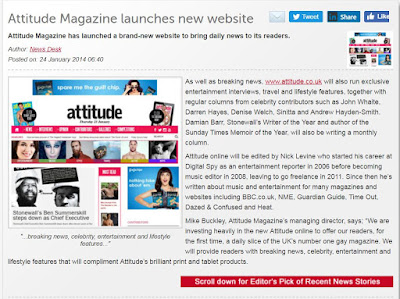The following articles and resources are vital case studies that can be used in the exam in order to explore industry issues.
0 - Attitude mini-research task (three minutes!)
- Who publishes Attitude?
- What other products does the publisher publish?
- Are they a major or independent publisher?
1 - Website launch
 |
| Via InPublishing. Click to see full size. |
2 - Media kit/press pack
Please click here to access Attitude's latest press pack.
3 - Hesmondhalgh - The Cultural Industries (3rd edition) (2013)
i
Many commentators go much further than I have above in pointing to change. Some claim, for example, that digitalisation has transformed cultural production beyond recognition. The internet and the mobile phone have triumphed. The music industry is dying or already dead, they say. Television is over. Book publishing as we knew it is finished. Yet these industries continue to pour out huge amounts of product, employ tens of thousands of people, produce considerable amounts of revenue, and occupy vast amounts of our time. Some optimistically see a new age where distinctions between producers and audiences disappear, and ‘users’ become the new creators. Commentary of this kind often implies, and sometimes explicitly states, that all the old notions and models need to be thrown out, and the history of cultural production is irrelevant because we are now living in an ‘information age’ rather than an ‘industrial age’ (or some other term that serves to simplify the past). Others see transformation just over the horizon. In many cases, it is unclear whether we are reading analysis of what is happening now, or a prediction of the future.
(ibid:3)
ii
Concentration, integration and co-opting publicity
Cultural industry companies deal with risk and the need to ensure audience maximisation by using strategies that are also apparent in other sectors.- Horizontal integration - They buy up other companies in the same sector to reduce the competition for audiences and audience time.
- Vertical integration - They buy up other companies involved in different stages of the process of production and circulation. Companies might buy ‘downstream’, such as when a company involved in making films buys a DVD distributor, or ‘upstream’, which is when a company involved in distribution or transmission (such as a cable television company) buys a programme-maker.
- Internationalisation - By buying and partnering other companies abroad, corporations can sell massive amounts of extra copies of a product they have already paid to produce (though they will have to pay new marketing costs, of course).
- Multisector and multimedia integration - They buy into other related areas of cultural industry production to ensure cross-promotion.
- Also important is the attempt to ‘co-opt’ (Hirsch, 1990[1972]) critics, DJs and various other people responsible for publicising texts, by socialising with them and sending them gifts, press releases, and so on.
(ibid:30-31)
iii
Is allowing companies to capture information about us a worthwhile price for the conveniences and pleasures afforded by search engines and social networking sites?
(cited in Bell & Johnson, 2018:230)